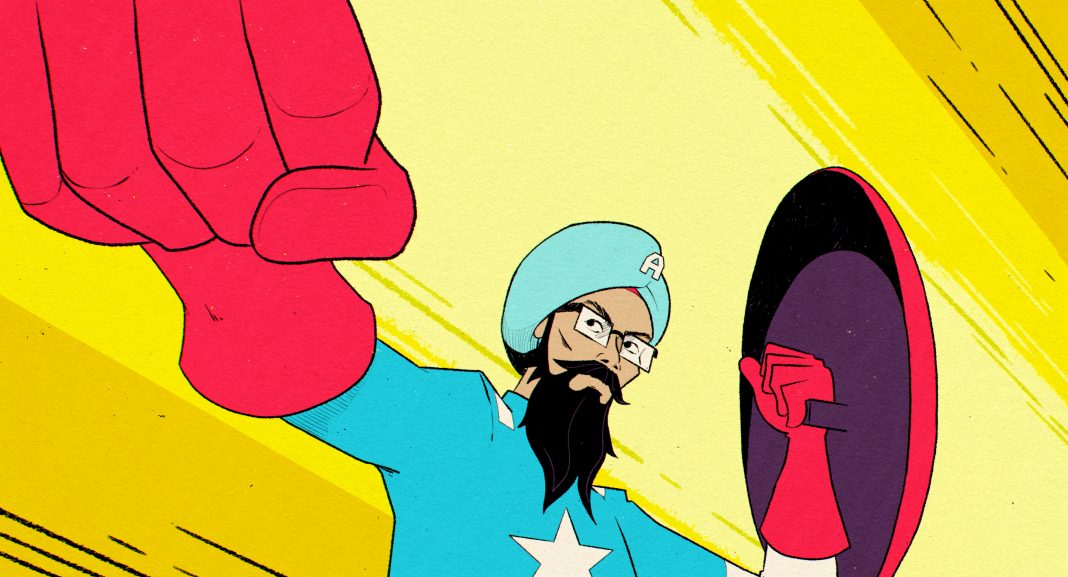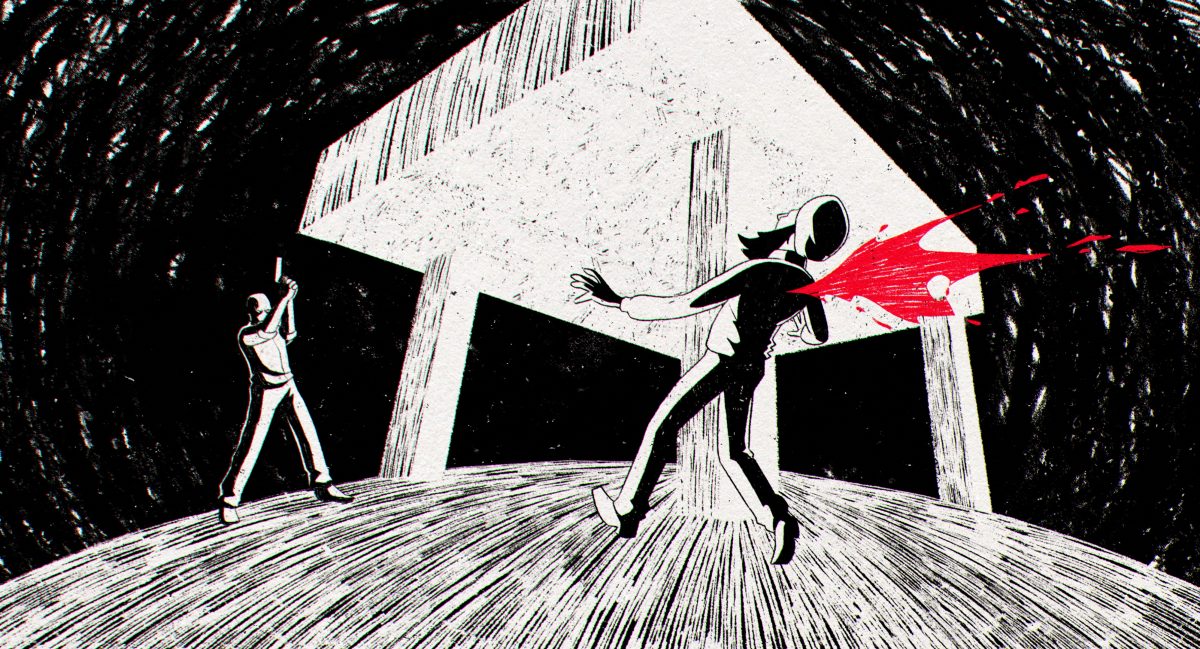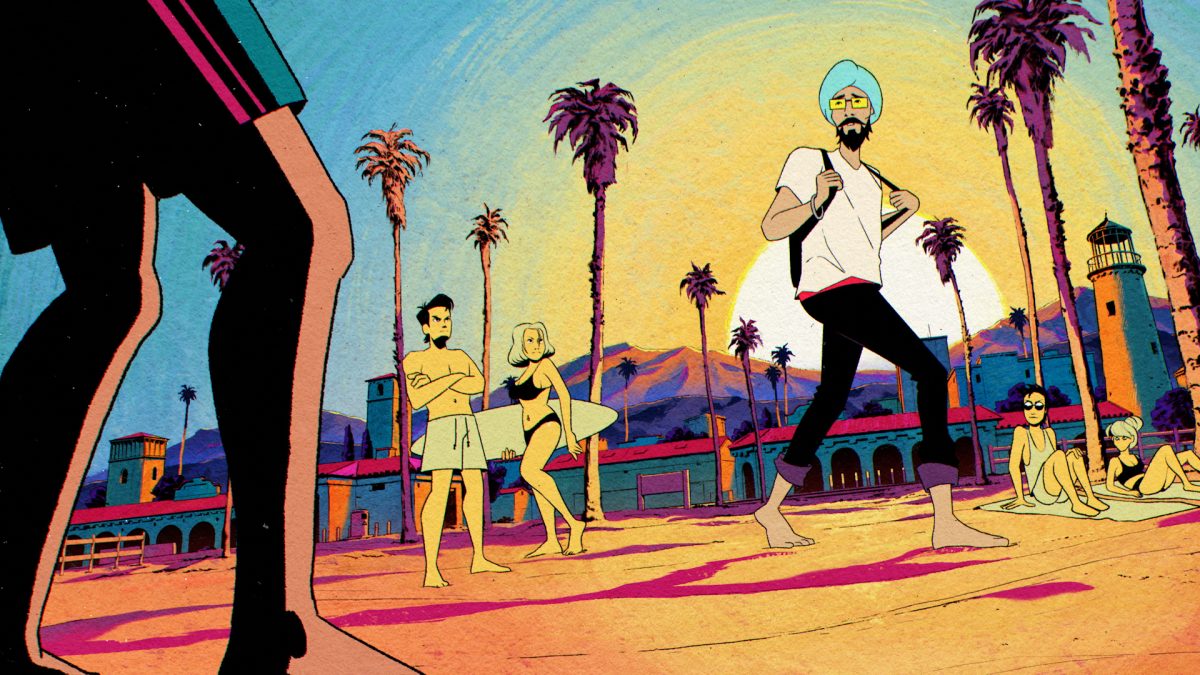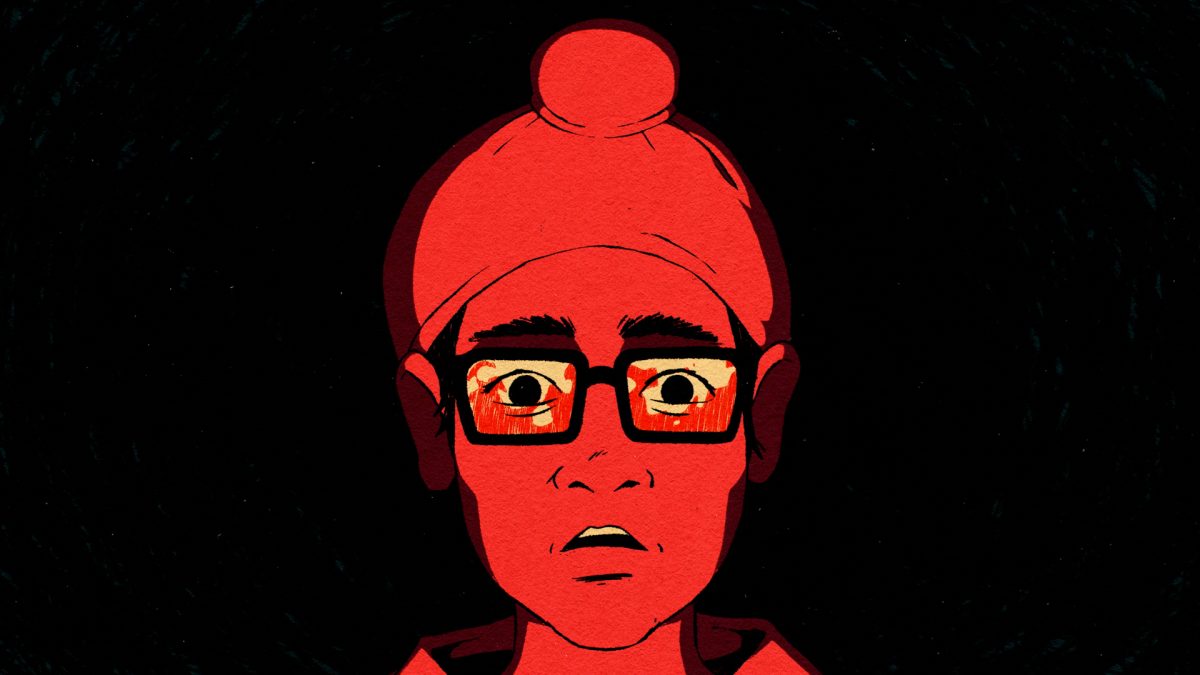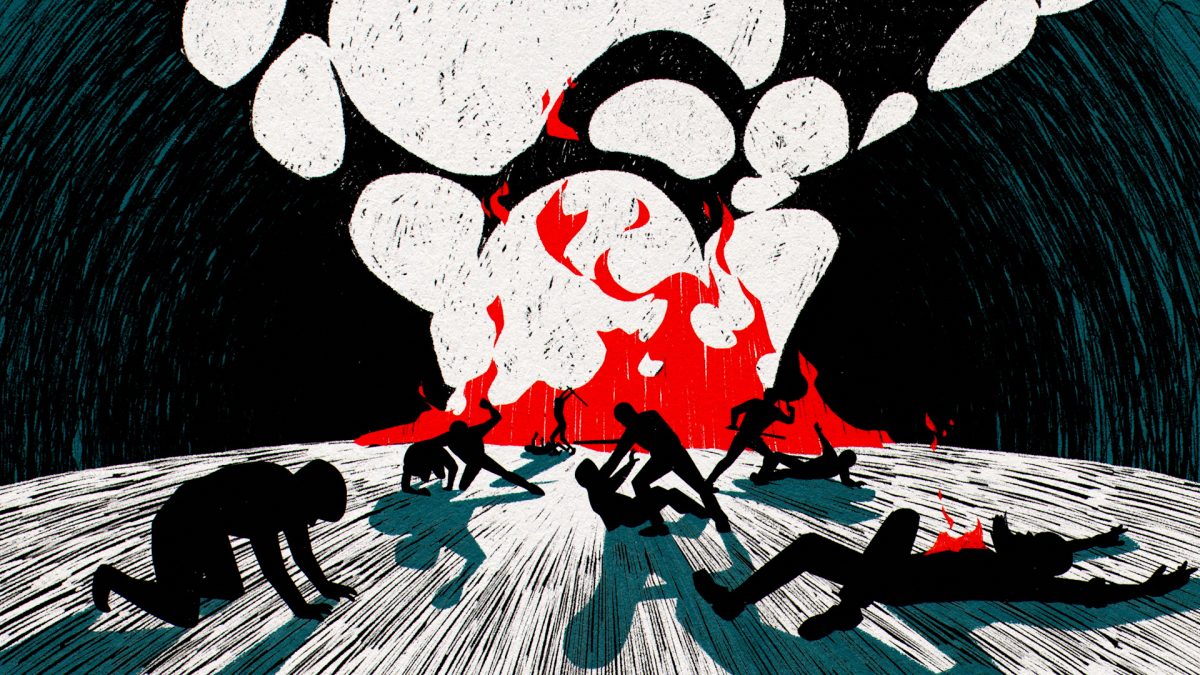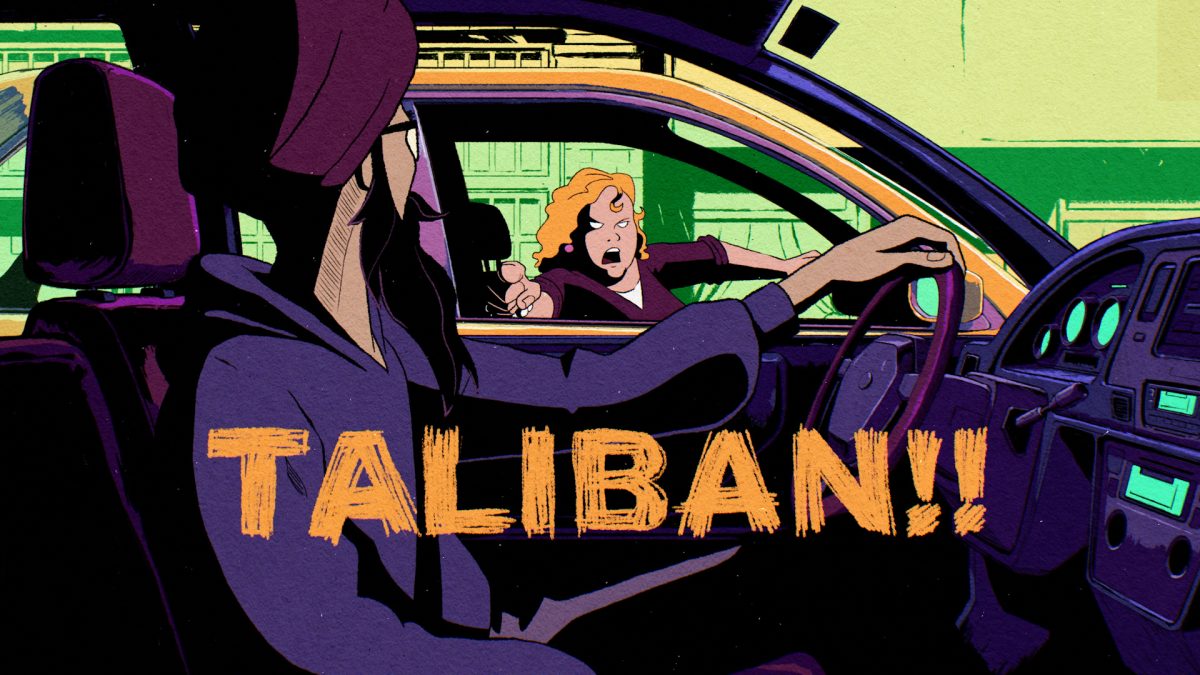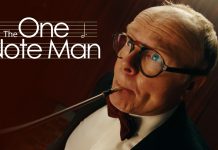The film taps into the craze for big-screen superheroes that have become more fully formed with the evolution of MCU and DC on the big-screen. When did you feel it was time to make a film based on the life experiences of Vishavjit?
More than ever, the world can benefit from a little more exposure to Vishavjit’s work as Sikh Captain America. Lack of representation, and especially positive representation, for people with turbans and beards, is still a huge issue in the American media.
By dressing up as a beloved superhero, Vishavjit literally flips the villain stereotype on its head and forces people to question their assumptions. As Sikh Captain America, Vishavjit is unquestionably heroic and unquestionably American.
Creating the short through animation also gives it extra power in some ways. How did you decide on the visual style of the short?
We worked with our animators as Studio Showoff to create the visual style. The film was hand-drawn digitally and uses layers of paper textures to make the film feel organic and grounded.
The colour palette switches frequently in the film as the drama rises and falls. As Sikh Captain America, the world is as bright and colourful as a 1950s comic book, but as hate and violence erupt on screen, the animation boils with harsh brush strokes in black, red and white.
How Long did it take to put together?
The whole process from conception to finished product took 4 years. We started just before the Covid pandemic, capturing all the details of Vishavjit’s story.
Storyboarding and animatics were the first outputs. Then we did a big crowd funding campaign to raise funds for animation. After 30 cuts we got the final version of the film ready.
Given how perceptions of diversity have changed since 9/11, where do you feel progress has been made and what challenges are still to be faced, given the the ‘War On Terror’ is never truly over yet?
We are talking a lot more about diversity in our culture today. There is progress being made on many fronts in terms of representation in mainstream media and entertainment.
But culture wars have only ramped up, especially in the last few years. We are not learning how to live with our perceived differences. We just keep displaying the so-called ‘other’ in the midst. From a Sikh perspective there is some increase in awareness but negative stereotypes still abound. Sikh youth report getting constantly bullied in school.
The latest FBI hate crime stats still show Sikhs in America as one of the top targets. This is why we are so driven and passionate about telling American stories that feature Sikh leads, characters and superheroes.
Who and what are your key cinematic influences?
For this film in particular, the colour palettes used in the Watchmen comics were a big inspiration. Additionally, the graphic novel Maus by Art Spiegelman was an inspiration for being able to communicate atrocities in a way that’s digestible.
Do you see a feature version of AMERICAN SIKH possible based on the power and impact of this short?
Yes absolutely. We have a vision of a feature-length animation that showcases an American superhero who happens to be Sikh, battling intolerance that is the biggest villain in our society today.
Diversity is a major issue in entertainment at present. What are you hopes for the immediate and long-term future?
Short term there has to be a continued push for showcasing stories that are not being told, stories that are underrepresented and giving voice to stories that are misrepresented.
Long term, the entire ecosystem needs to have diverse representation from content creators, those who fund projects, those who make decisions on what gets to be shown and of course in front of the camera.
Both visions will require constant push by content creators from diverse backgrounds to keep creating their vision and pushing to expand the cultural envelope. Unfortunately, this is not a benevolent exercise on the part of a demographic dominating the cultural landscape. It is an advocacy push across all fronts fro a much more inclusive entertainment milieu.
What issues and themes are you keen to explore in future work?
Certainly issues of intolerance, bias and prejudice but from an angle of how we all have the potential of harboring these vices but at the same time we have the potential to become better versions of who we are.
Vishavjit uses this approach in his DEI public speaking storytelling work in schools, companies and organizations with a lot of success in opening self-reflective conversations about becoming a better version of who we are by learning from the past.
We also want to tell American stories be it sci-fi, thrillers, mysteries etc. that have Sikh and other underrepresented characters. We want audiences to consume super entertaining stories with one key change from the status quo today. There are turbaned and bearded leads in these stories.
Tell us more about Sikhtoons.
Sikhtoons was born in the aftermath of the 9/11 tragedy when Americans of darker hue with facial hair became targets of ignorance, bias, intolerance and vulnerability.
An op-ed cartoon in the weeks after 9/11 that captured this predicament provided the spark for me to start cartooning with characters full of turbans and beards. 10 years later I illustrated Captain America with a turban and beard inspired by the first Marvel Captain America movie poster.
That illustration took a life of its own and I started dressing up as Captain America as a social experiment in who gets to be seen as an American and American superhero. I started travelling all over the nation to share my story and dressing up as Captain America along the way. Today, I work in the DEI space across many fronts. Media content creation, public speaking and DEI advocacy.
Art has been at the forefront of this journey for me. Storytelling is one of the most powerful tools we possess. It can be used for both good and bad. We need to tip the tables well into the good side of things. It is not an easy or soon-to-end task. We have to keep at it like a daily meditation.
Vishavjit, how has your life changed and evolved with the Sikh Captain America alter-ego?
Captain America is a fictional story created in 1941. Even little kids know it is a fictional superhero.
But the power of the story has allowed me to connect with the hearts and minds of countless people across the globe. My Captain America alter-ego has found many open doors for me to share my story and talk about the hard things around vulnerability, racism and how to become agents of good.
My life has taken an entirely new path that I never dreamed of. Tragedies and vulnerabilities create potential for great change. Art in these tender moments can take us on very unique journeys. I have been fortunate to have cartoons and movie posters that offer the possibilities of paths that have taken me on a compassion and empathy-flavoured route.
The short premiered at Tribeca. What was the experience like showing this to New Yorkers, given the impact of those tragic memories in September 2001?
We have heard from many New Yorkers who have seen the film across multiple screenings.
Everyone talks about the power of the story powered by the dark moments (me surviving a genocidal massacre in 1984 in India and post 9/11 hate) but offering hope from how we respond to these tragedies. We can get angry, jaded, and feel helpless among other things.
We can also go out on a limb to find ways to connect with each other. After the World Premiere, we spoke to Whoopi Goldberg who curated the short animation cluster at Tribeca. She mentioned watching the film for the first time and the first sequences in the film are very dark.
She was wondering what is this. And when she finished watching the film, she was in a space filled with hope.
How has the festival circuit helped your film?
We are starting our festival journey at Tribeca which we are very thankful for. We will be screening at more festivals in the coming month.
The Tribeca World Premiere is already bringing more attention and connections from audiences and those who are part of the entertainment landscape. We are excited about the opportunities that await us from festival travels.


